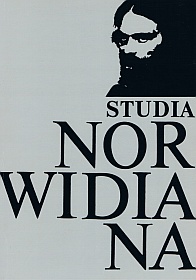Three Translations of Fatum into English
Abstract
Before attempting the evaluation of the three translation of Fate into English, the author of the article pointed out structural and semantic dominants which compose the specific quality of Norwid's poem and therefore should be conveyed in its translations. She mentioned six features respectively: the crucial idea of the poem about “taking advantage of one's foe”; the “eye fight” between a man and his enemy, Fate; the semantic, phonetic and syntactic contrast between the two parts of the lyric; the double nature of time and the brevity and typography of the text.
Jerzy Peterkiewicz and Burns Singer (Five Centuries of Polish Poetry. London 1960 p. 81) made an assumption that the structure of the poem is most important. They maintained the rhymes of the original, but at the same time lost its brevity. They didn't convey in depth any of the six dominants. The idea of the poem was shortened in their text to a remark about an artist's fight for an aesthetic shape of his work.
Adam Czerniawski (Polish Poetry Supplement No 7, Oficyna Poetów No 2 (29). London, May 1973 p. 17) stressed the importance of the layer of meanings. However his translation was more faithful to the original structure than that of Peterkiewicz and Singer's, but it changed the poem's sense into the opposite. The second and the third dominants were partly translated while the fourth and the fifth ones were fully demonstrated.
For Edmund Ordon (Przekład artystyczny. Pod red. S. Pollaka. Wrocław 1975 p. 242) the structure and the meaning of the original poem were equally important. Apart from the contrast between the two parts of the lyric, he succeeded in maintaining its other dominants.
The comparison of all three English translation of Fate showed a paradox: theoretical assumptions which stressed the significance of one feature of the poem led in practice to the loss of this very feature and the maintainance of all others less important for the translator.
The evaluation of the translation depends on the criterion used to ``measure” the text. In the writers opinion Adam Czerniawski's work should be regarded as the best in terms of the artistic value of the text. When loyalty to the meaning of the poem is the main criterion, she estimates Edmund Ordon's translation as the highest. Yet she makes it clear that none of the translation is ideal and one ought to read each to obtain a full picture of Norwid's poem.
Copyright (c) 1996 Studia Norwidiana

This work is licensed under a Creative Commons Attribution-NonCommercial-NoDerivatives 4.0 International License.





